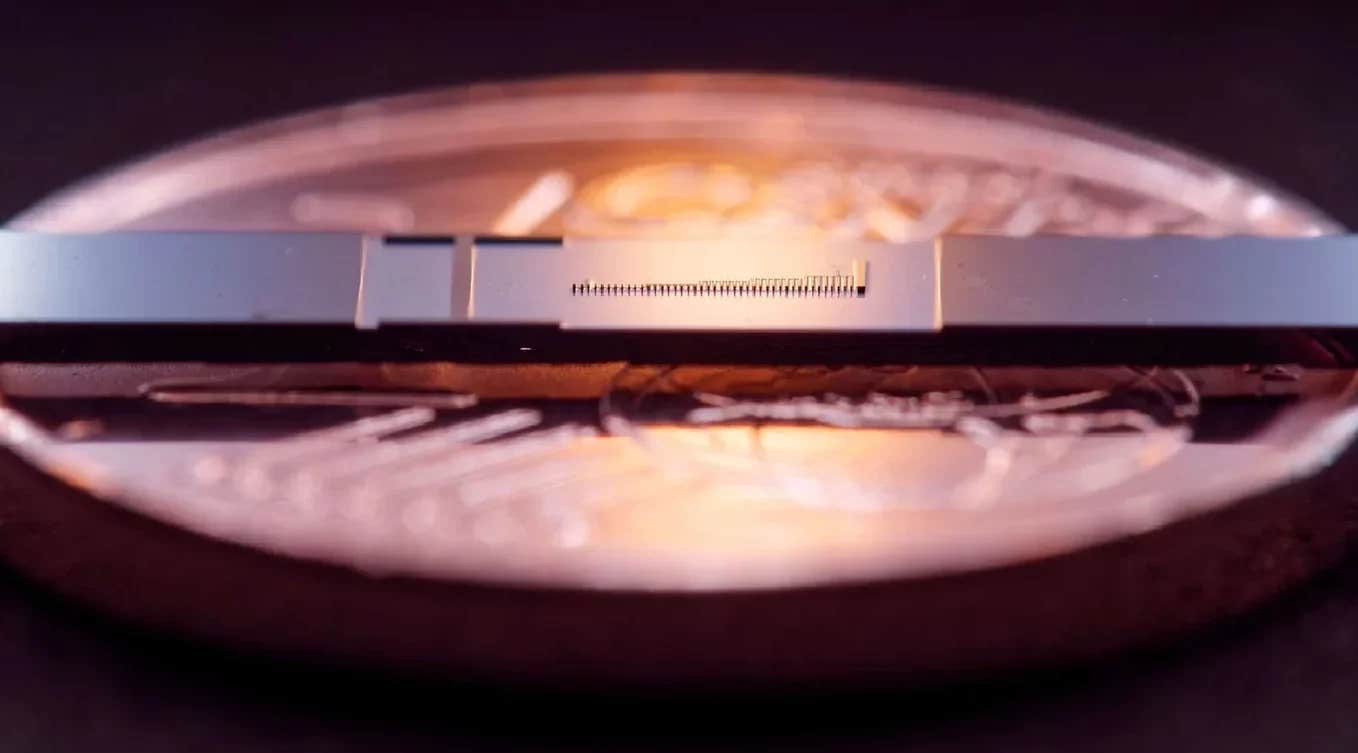World’s smallest particle accelerator could revolutionize medicine and physics
A microchip-sized particle accelerator has been successfully tested, marking a breakthrough in miniaturized high-energy physics.

A microchip-sized particle accelerator has been successfully tested, marking a breakthrough in miniaturized high-energy physics. (CREDIT: FAU/Laser Physics, Stefanie Kraus, Julian Litzel)
Scientists have successfully activated the world’s smallest particle accelerator, a device as compact as a coin. This breakthrough, which could transform fields ranging from medicine to physics, represents a significant step toward miniaturized particle acceleration technology.
Traditional particle accelerators rely on radio-frequency waves and metallic structures to propel charged particles. These methods impose size and cost limitations due to the constraints of radio-frequency fields, which can only withstand acceleration gradients in the range of megavolts per meter.
In contrast, dielectric materials can tolerate optical fields exceeding 10 gigavolts per meter, enabling much stronger acceleration gradients.
The new approach, known as a dielectric laser accelerator (DLA), leverages nanophotonic structures to synchronize optical nearfields with moving charged particles. This configuration achieves acceleration rates up to 100 times greater than conventional radio-frequency-based systems, drastically reducing both the size and cost of accelerators.
The nanophotonic accelerator measures just 500 micrometers in length, making it 54 million times smaller than the 27-kilometer-long Large Hadron Collider (LHC) at CERN.
A key challenge in any accelerator is maintaining particle confinement to prevent energy loss. In the DLA, confinement occurs within a narrow, nanometer-wide channel, structured to keep electrons focused as they gain energy.
To overcome the focusing limitations posed by Earnshaw’s theorem, researchers employed an alternating phase focusing (APF) technique. This method alternates between focusing and defocusing forces to guide the electrons along their trajectory, ensuring consistent acceleration.
Historic First Test of a Chip-Based Accelerator
This device, called the nanophotonic electron accelerator (NEA), is a microchip containing a vacuum channel lined with thousands of tiny pillars. When laser beams strike these pillars, they generate the fields necessary to accelerate electrons through the structure.
Researchers at Friedrich–Alexander University of Erlangen–Nuremberg (FAU) in Germany successfully demonstrated the NEA’s capabilities by accelerating electrons from 28.4 kiloelectron volts (keV) to 40.7 keV, a 43% energy increase.
Related Stories
This milestone, published in Nature, marks the first successful demonstration of a nanophotonic electron accelerator—a concept first proposed in 2015.
"For the first time, we really can speak about a particle accelerator on a [micro]chip," said Roy Shiloh, a physicist and co-author of the study. A team at Stanford University has reportedly achieved similar results, though their findings are still under review.
Unlike the LHC, which uses more than 9,000 superconducting magnets to accelerate particles to nearly the speed of light, the NEA relies on laser beams to excite the tiny pillars inside its structure. While this method is far less powerful, it is significantly more compact and energy-efficient.
Potential for Medical and Scientific Applications
The electrons accelerated by the NEA carry only about a millionth of the energy produced by the LHC. However, researchers believe they can enhance its power by incorporating new materials or stacking multiple acceleration structures. Even with improvements, the NEA will never rival large-scale colliders, but its strengths lie elsewhere.
The primary goal of developing miniaturized accelerators is not just high-energy physics but also practical applications in medicine. The high-energy electrons generated by the NEA could be used in precise radiotherapy techniques, potentially reducing the harmful side effects associated with conventional radiation treatments.
Tomáš Chlouba, the study's lead author, envisions a future where miniaturized accelerators could be integrated into endoscopes for targeted cancer treatment. "If we can make a particle accelerator small enough to fit inside a medical device, we could deliver highly localized radiation directly to tumors," Chlouba explained. However, he cautioned that such applications remain distant and will require further technological refinements.
A New Era of Miniature Accelerators
The successful operation of the NEA marks a turning point in accelerator physics. While large-scale particle colliders will continue to play a crucial role in fundamental research, miniaturized accelerators could revolutionize medicine, materials science, and electronics.
The ability to produce high-energy electrons within a microscopic device opens the door to portable diagnostic tools, advanced imaging systems, and new methods for studying matter at the nanoscale.
As researchers refine the technology, the applications of nanophotonic accelerators will continue to expand, potentially reshaping multiple scientific and medical fields.
This tiny accelerator, no larger than a grain of rice, demonstrates that the future of high-energy physics is not just about building bigger machines—but also about making them smaller and more accessible.
Note: Materials provided above by The Brighter Side of News. Content may be edited for style and length.
Like these kind of feel good stories? Get The Brighter Side of News' newsletter.
Joseph Shavit
Head Science News Writer | Communicating Innovation & Discovery
Based in Los Angeles, Joseph Shavit is an accomplished science journalist, head science news writer and co-founder at The Brighter Side of News, where he translates cutting-edge discoveries into compelling stories for a broad audience. With a strong background spanning science, business, product management, media leadership, and entrepreneurship, Joseph brings a unique perspective to science communication. His expertise allows him to uncover the intersection of technological advancements and market potential, shedding light on how groundbreaking research evolves into transformative products and industries.



